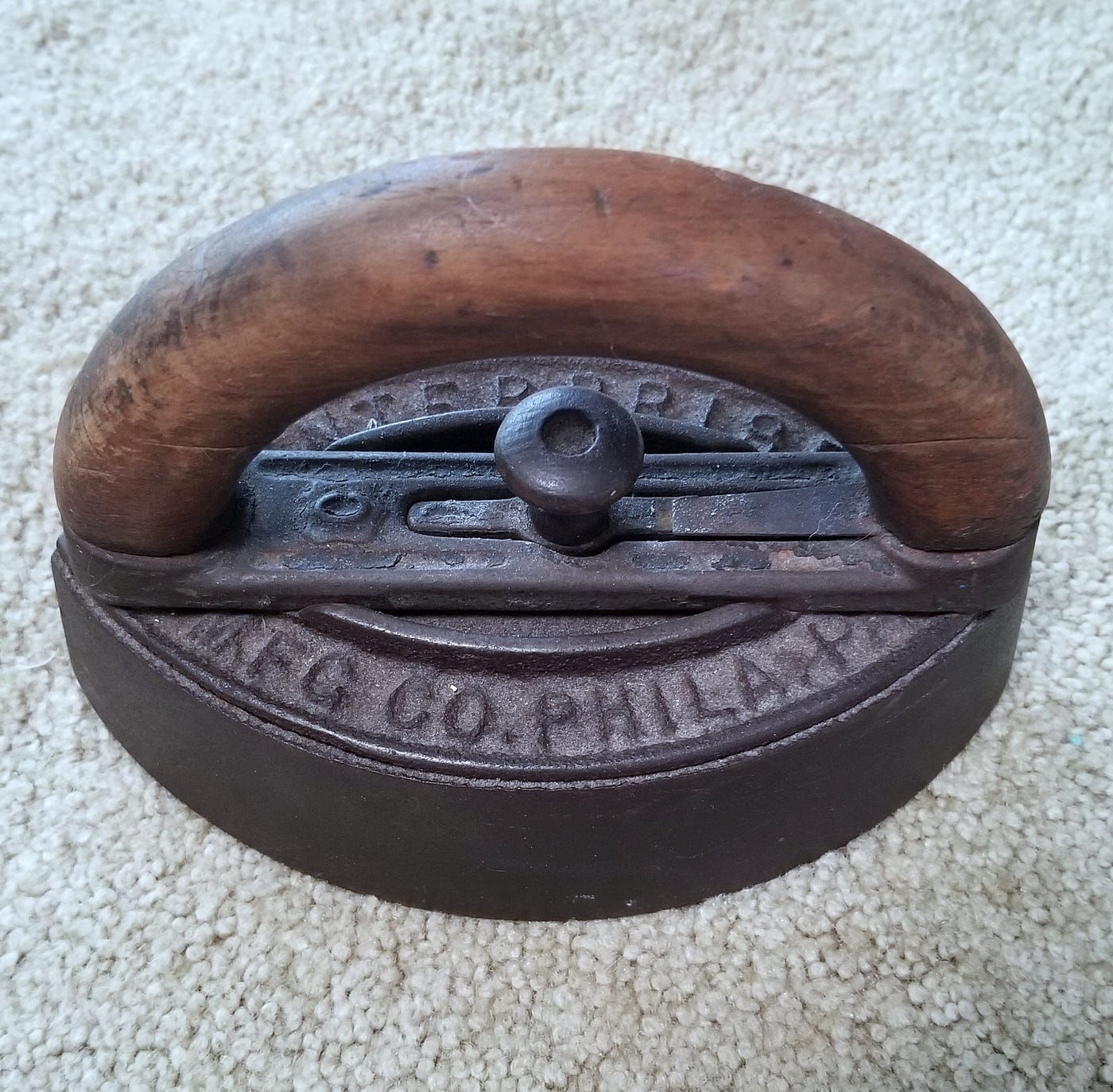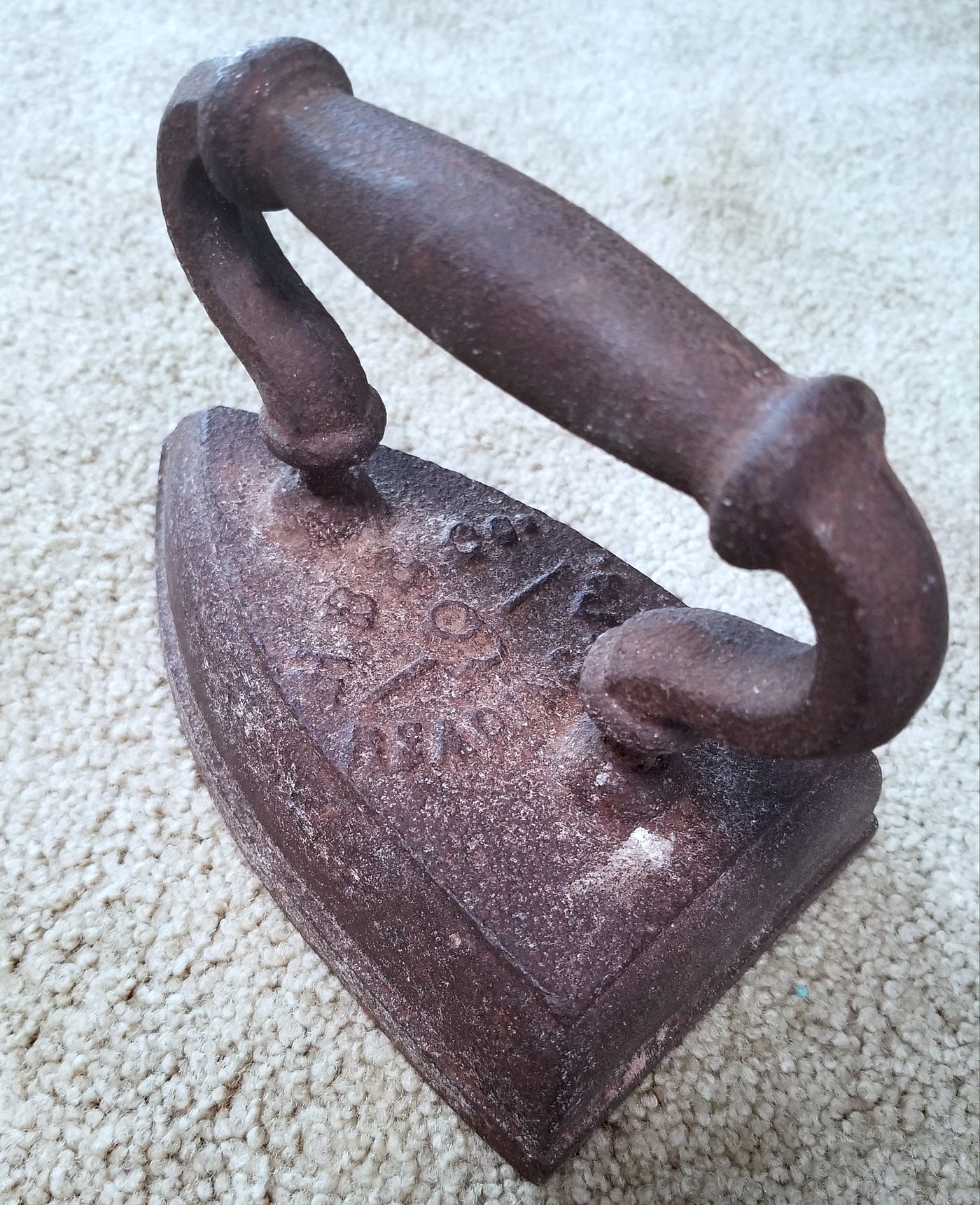Sad Iron: Unveiling the History Behind the Name
A sad iron, also known as a flat iron, is a heavy, often metal tool used for pressing clothes. These irons were heated on a stove or over a fire before electricity.
The sad iron is a staple in the history of domestic chores, dating back to when households tackled laundry by hand. Before the advent of modern appliances, these irons were essential for smoothing out wrinkles and giving fabrics a crisp appearance.
They came in various weights and sizes to suit different garments and fabrics. Collectors and antique enthusiasts often seek out sad irons for their historical value and quaint aesthetic. With modern technology, the sad iron has evolved into the electric iron, making the process more efficient and less labor-intensive. Understanding the evolution of the sad iron offers insight into the development of household technology and the progression of domestic life.

Credit: medium.com
The Origins Of Sad Iron
The journey of the sad iron begins deep in history. These simple tools revolutionized garment care. Let’s explore their origins and understand the story behind their unique name.
Tracing Back To The Iron Age
The sad iron’s story starts in the Iron Age. People discovered iron’s durability and heat-conducting abilities. They used these properties to create the first irons.
- Simple Designs: Early irons were slabs of metal, heated in fires.
- Evolution: Over time, irons evolved with handles for ease of use.
- Global Use: Various cultures adopted irons for smoothing clothes.
Etymology: Why ‘sad’ In Sad Iron?
The term ‘sad’ is old English for ‘solid’. It refers to the iron’s heavy weight. ‘Sad’ had nothing to do with emotions in this context.
| Term | Meaning | Context |
|---|---|---|
| Sad | Solid, heavy | Describes the iron’s weight |
In the past, ‘sad’ commonly described weighty objects. This usage faded over time, leaving us with the curious name ‘sad iron’.
Design And Functionality
The Sad Iron revolutionized the way we smooth clothes. Its design combined simplicity with efficiency. These irons made ironing quicker and less tiresome. Let’s explore the components and the evolution of these tools.
Basic Components And Materials
Sad Irons consist of a few key parts. Each part plays a role in pressing clothes.
- Handle: For holding and maneuvering the iron.
- Base: The heavy, flat surface that presses the fabric.
- Heating Element: Traditionally, a solid metal slab.
Materials used were typically cast iron and wood. Cast iron was used for the base, and wood for the handle.
The Evolution Of Ironing Tools
Ironing tools have evolved greatly over time.
- Stone and Glass: Early tools for pressing clothes.
- Hand Irons: Evolved into metal devices heated on stoves.
- Electric Irons: Modern irons with internal heating.
This evolution led to more efficient and convenient ironing.
From Charcoal To Electricity
The journey of the sad iron from its humble charcoal beginnings to modern electric models is a tale of innovation and convenience. This transformation revolutionized the way we approach one of the most common household chores: ironing.
The Transition To Modern Irons
Early irons were heated by fire or filled with hot coals. This made them heavy and hard to handle. They also posed a risk of burning clothes. As technology advanced, so did irons. By the late 19th century, the electric iron was introduced. It changed everything.
- Electric irons became popular quickly.
- They offered a consistent temperature for better results.
- Temperature control became an option.
- They were safer and easier to use than charcoal irons.
Impact On Household Chores
Electricity in ironing made smoothing out wrinkles a simpler task. No more burning coals or uneven heat. Just plug in the iron and you’re ready to go. Housework became faster and less tiring.
| Charcoal Irons | Electric Irons |
|---|---|
| Heavy and cumbersome | Lighter and more manageable |
| Uneven heating | Even and adjustable heat |
| Time-consuming | Quick and efficient |
With electric irons, ironing became a task anyone could handle. It saved time and energy, allowing for more leisure or other work.

Credit: medium.com
Manufacturing And Industry
The ‘Manufacturing and Industry’ of sad irons revolutionized home life. These heavy, flat irons, once heated on stoves, made ironing clothes possible before electricity. Their production and distribution marked a significant phase in domestic tool manufacturing. Let’s delve into the key historical manufacturers and the mass production processes that brought these irons to households worldwide.
Key Manufacturers In History
Several companies stood out in sad iron manufacturing. Among them, Enterprise Manufacturing Company and Grismore-Spencer Company were prominent. They innovated designs and made ironing more efficient. Their products became household staples.
- Enterprise Manufacturing Company: Known for quality cast iron products.
- Grismore-Spencer Company: Innovators of the “swivel” iron.
Mass Production And Distribution
Mass production of sad irons began in the late 19th century. This was a game-changer. Factories could now make sad irons in large quantities. The use of assembly lines and specialized machinery made this possible. Distribution channels were set up to deliver sad irons to stores across the country.
| Year | Advancement |
|---|---|
| 1860s | Introduction of assembly lines |
| 1890s | Widespread distribution begins |
With these advancements, sad irons became accessible to more people. This helped improve the task of ironing, making it less cumbersome.
Cultural Significance
The cultural significance of the sad iron spans centuries. These irons tell stories of social norms, daily life, and artistic inspiration. Let’s explore how sad irons left their mark on culture.
Sad Iron In Everyday Life
Before the advent of modern appliances, sad irons were household staples. Families relied on them to press clothes and linens. These irons were heated on stoves or near the fireplace, a task often done by women. The labor was intense, yet it played a key role in domestic life.
- Heating: Required a fire or stove.
- Handling: Heavy, with a detachable handle.
- Usage: Daily necessity for presentable attire.
Representation In Art And Literature
Sad irons appear in various art forms. Painters and writers have used them to depict the era’s domestic life. They symbolize the unseen labor behind the genteel society of the past. In literature, sad irons evoke themes of hard work and the role of women in the household.
| Art Form | Representation |
|---|---|
| Paintings | Domestic scenes, historical context |
| Literature | Themes of diligence, women’s roles |
Collectors And Antiques
The world of Sad Irons is rich with history and charm. Collectors find these antiques fascinating. Each iron tells a story from the past. This makes them highly sought after by enthusiasts and collectors alike.
The Hobby Of Collecting Sad Irons
Collecting Sad Irons is a unique hobby. People of all ages enjoy it. They search for rare and unusual irons. Collectors often focus on different aspects. Some like the history, others the design.
- Historical significance
- Unique designs and shapes
- Rarity and condition
Preservation And Value Estimation
Keeping Sad Irons in good shape is important. It helps them last longer. Clean and store them properly. This keeps their value high.
Estimating the value of a Sad Iron can be tricky. It depends on:
| Factor | Impact on Value |
|---|---|
| Age | Older might be more valuable |
| Condition | Better condition, higher value |
| Rarity | Rarer items fetch higher prices |
Find a trusted appraiser for an accurate estimate. They can give you the best advice.
Usage Tips And Techniques
Mastering the art of using a sad iron can transform your ironing experience. This section dives into essential Usage Tips and Techniques to help you get the best results. Whether you’re dealing with delicate fabrics or stubborn wrinkles, these strategies will ensure your clothes look crisp and fresh.
How To Properly Use A Sad Iron
- Heat the iron adequately before use. Test its warmth on scrap fabric.
- Place your garment on a smooth, flat surface. A padded ironing board is ideal.
- Iron clothes inside out to prevent shine, especially on dark colors.
- Use gentle, circular motions for areas with buttons and folds.
- Keep the iron moving to avoid scorching the fabric.
Maintenance And Care
Caring for your sad iron ensures its longevity and performance. Follow these simple steps:
- After each use, let the iron cool completely.
- Wipe the iron plate with a damp cloth to remove residue.
- Dry thoroughly to prevent rust.
- Store in a dry place, away from moisture.
Occasionally, apply a small amount of cooking oil on the iron plate. This prevents rust and keeps the plate smooth.
| Task | How Often |
|---|---|
| Clean Plate | After Each Use |
| Check for Rust | Monthly |
| Oil Plate | Every 3 Months |
The Legacy Of Sad Irons
The sad iron, a relic of the past, has shaped the way we think about household chores. This simple tool, once a staple in homes around the world, has paved the way for modern appliances we can’t imagine living without. Its solid design and heating method influenced the development of today’s streamlined, electric irons. Let’s explore the impact of sad irons and their presence in our culture today.
Influence On Modern Appliances
The transition from sad irons to electric irons was monumental. It introduced convenience and efficiency to ironing. Modern irons now come with features like steam, temperature control, and automatic shutoff. These advancements all trace back to the fundamental design and functionality of the sad iron. The legacy of sad irons lives on in every sleek and multi-functional ironing device in our homes.
Sad Irons In Museums And Exhibits
Sad irons have not been forgotten. They are displayed in museums worldwide, showcasing the evolution of domestic life. Visitors can see the variety of sad irons, from the basic flat iron to more elaborate models with detachable handles and bases. These exhibits often include interactive elements, like demonstrations or touchable replicas, to engage visitors and connect them with the past. The story of sad irons is preserved, informing and inspiring future generations.
Frequently Asked Questions
Why Do They Call It A Sad Iron?
They call it a “sad iron” because “sad” is an old English word meaning “heavy,” reflecting the iron’s substantial weight.
What Is The Difference Between A Sad Iron And A Flat Iron?
A sad iron is an old-fashioned, heavy iron heated on a stove, while a flat iron is a modern, electric appliance for pressing clothes.
How Do You Identify A Sad Iron?
To identify a sad iron, check for a solid metal body, a detachable handle, and a flat, smooth base. Look for manufacturer marks or numbers indicating the iron’s weight.
What Years Were Sad Irons Used?
Sad irons were commonly used from the late 17th century until the early 20th century.
Conclusion
Wrapping up our journey through the history of the sad iron, we’ve uncovered its multifaceted past. From a household necessity to a collector’s gem, its tale is rich with heritage. Remember, the evolution of ironing tools mirrors our societal progress.
Cherish these relics; they’re windows to our cultural fabric. Keep exploring history’s treasures!
